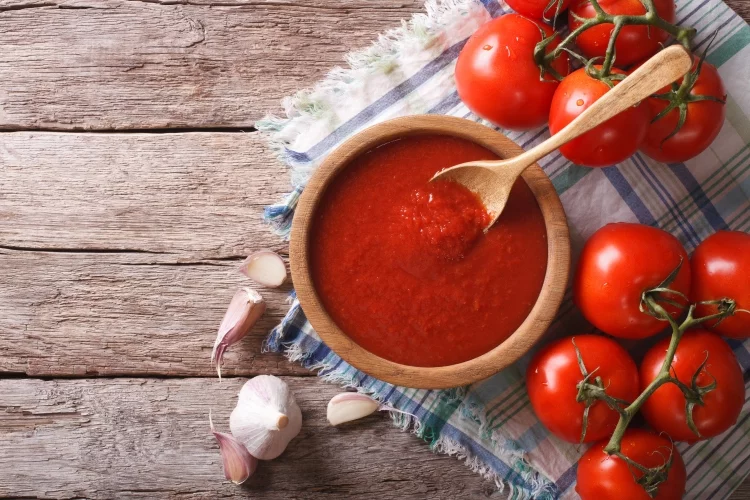by Christopher Jones
Are you aware that there are literally hundreds of recipes that require tomato paste? A lot of newcomers in cooking are actually spooked when they see tomato paste in the recipe and there is no specific designated replacement.
Now tomato is a highly versatile fruit—and yes larval ones, it’s a fruit—that you can turn in a pinch, any product based on it to take on double roles. And while there is no real substitute for tomato paste when the recipe requires it, it only takes a little kitchen wizardry to create tomato paste aside from buying the canned version.
Obviously, tomato paste is based on tomatoes. All you need, therefore, is to find ways to create it based on what tomato product you have lying around. No need to panic, there is really nothing magical about what I’m going to show you. I have chosen five clever replacement methods to create tomato paste and the directions are easy to follow.
Contents

In this article, I’m going to share with you the result of years of personal experimentation and cooking experience. Aside from that, a friend of mine who is also a chef has passed down his own tricks in making tomato paste along with the ingredients he used.
Finally, the resulting replacements are the result of my own intensive research and I will provide these resources to you so you too can make your own tomato paste without buying an actual can. Try to pay attention to the recipes and replacement options that I provide along with the links that are scattered all over this article.
When cooking a recipe that needs tomato paste, you need to have some tomato-based product to replace it. There’s just no other way that you can spin it. You can’t just pick any thickening because it won’t taste the same.
There are five replacement methods that I’m going to share with you in this article, four of which are really easy to follow. The fifth, well, it’s a bit technical but there are some culinary principles that you will discover along the way. Don’t worry though, because the hardest method also delivers the best quality of tomato paste.
Tomato sauce is the result of reducing the moisture of the tomato fruits. The process will produce a sweet concentrate which you can then use a binder, thickener or sweetener in many recipes. But you can’t just simply add tomato sauce in place of tomato paste in a recipe, you have to allow for a little more extra time for that.
Suppose you run out of paste and when you check the pantry, you don’t have tomato sauce but have a lot of canned diced tomatoes lying around? No need to worry. You don’t have to rush to the store and buy a can of tomato paste, here is the recipe for it:
Did you remember that I mentioned a replacement that my chef friend taught me? Well, here it is. There’s actually a lot that you can do with a can of plain diced tomatoes, preferably the one without seasonings like garlic, oregano or basil. He calls it the “Chain Replacement Method” because you can actually get everything from just diced tomatoes because it chains so well.
The homemade roasted tomato paste is my de facto replacement method and I believe this is better than the rest. It requires a little bit of skill to prepare but it will really improve whatever recipe that requires garden variety paste. This will make you crave for more food compared to the rest of my replacement methods.
Ingredients
Direction
After baking, the paste will take on a brick-like color and will reduce to half its original amount. Divide the paste into 4-ounce jars but leave a quarter inch at the top of the jar as a preservation technique.
If it happens that you’re out of time and the ingredients are just not there, grab a ketchup and a little tomato sauce as a quick hack. Don’t be scared to experiment with the ratio to find the best consistency and don’t forget to reduce it by cooking.
The best substitute for tomato paste as far as I’m concerned is my homemade roasted tomato paste. This requires a bit of skill but you won’t regret the result. With 10 pounds of raw tomatoes, you will be left with plenty of tomato paste to face the future.
How about you? Do you have a favorite replacement method you’d like to share? Drop a comment below and share your wisdom.
 |
 |
 |
 |
 |
 |
 |
 |

About Christopher Jones
Chris is a true globetrotter. He has been to many destinations and tried different types of food from all over the world, yet he still loves finding new places and tasting their specialties. Chris has always had an entrepreneurial spirit and so he decided to go back to school at age 24 for his MBA at University of San Francisco so that he could have a better understanding of business strategy in order to start his own company. His favorite motto is “how can one live well, travel well, and work well without having good food every time?”
Check for FREE Gifts. Or get our Free Cookbooks right now.
Disable the Ad Block to reveal all the recipes. Once done that, click on any button below
 |
 |
 |
 |